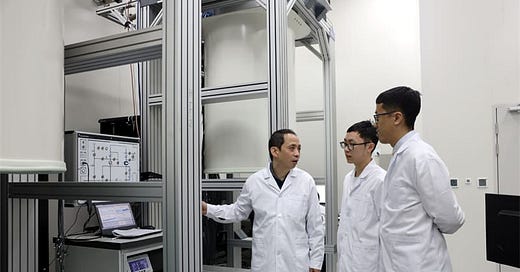Chinese scientists led by Pan Jianwei, Zhu Xiaobo, and Peng Chengzhi have unveiled a superconducting quantum computer prototype named “Zuchongzhi 3.0” with 105 qubits in Hefei, Anhui Province.
This system features 182 couplers and processes quantum random circuit sampling tasks at a speed quadrillion times faster than the world’s most powerful supercomputer, surpassing Google’s latest results by a factor of 1 million.
The achievement sets a new record for quantum computational advantage within superconducting systems. It underscores China’s advancements in quantum computing, positioning it as a global leader alongside the United States in this rapidly evolving field.
China’s Breakthrough in Quantum Computing
Chinese scientists have unveiled a significant advancement in quantum computing by developing “Zuchongzhi 3.0,” a superconducting quantum computer prototype featuring 105 qubits. This milestone represents a substantial leap forward in quantum computational power, achieving a processing speed quadrillion times faster than the world’s most influential classical supercomputers and surpassing recent results from Google. The system also includes 182 couplers, enhancing its ability to perform complex quantum operations.
The achievement of “Zuchongzhi 3.0” demonstrates China’s continued progress in the field of quantum computing, following previous milestones such as the development of “Jiuzhang” and “Zuchongzhi 2.1.” These advancements highlight the nation’s commitment to achieving quantum computational advantage, a critical step toward practical applications of quantum technology. The research team, led by prominent scientists including Pan Jianwei and Zhu Xiaobo, has emphasized improving qubit control precision and scalability for future developments.
The Development of Zuchongzhi 30
The research team, led by scientists including Pan Jianwei and Zhu Xiaobo, has emphasized improving qubit control and integration for future applications. Their work on quantum error correction, with a focus on achieving code distances of 7, 9, and eventually 11, demonstrates a strategic approach to addressing key challenges in large-scale quantum computing.
The system’s architecture, featuring 182 couplers, enables precise control over qubit interactions, facilitating complex quantum operations. This design reflects ongoing efforts to enhance scalability and precision, which are critical for advancing toward large-scale, fault-tolerant quantum systems. The research team has emphasized the importance of improving qubit control and integration, with current work focusing on achieving code distances of 7, 9, and 11 in quantum error correction protocols.
Zuchongzhi 3.0 underscores China’s position as a key player in global quantum technology research by demonstrating quantum computational advantage at this scale. The system’s capabilities align with broader goals to develop practical applications for quantum computing, addressing challenges beyond classical systems’ reach.
Future Directions in Quantum Error Correction
This advancement builds on earlier milestones such as the 76-qubit “Jiuzhang” and the 62-qubit “Zuchongzhi 2.1,” showcasing a clear progression in quantum computing capabilities.
The system’s architecture, featuring 182 couplers, enables precise control over qubit interactions, facilitating complex quantum operations. This design reflects ongoing efforts to enhance scalability and precision, critical factors for advancing toward large-scale, fault-tolerant quantum systems. The research team has emphasized the importance of improving qubit control and integration, with current work focusing on achieving code distances of 7, 9, and eventually 11 in quantum error correction protocols.
More information
External Link: Click Here For More





please review your drafts before releasing. they routinely contain unnecessary repitition of text material (routinely three times). this makes for boring, lengthy reading that conveys an amateur appearance
@bill Thanks for the feedback! Much appreciated. The article has been edited down.